By Sharon Omahen
University of Georgia
If this year's holiday turkey is safely tucked away in the family freezer, remember to take it out in time for safe thawing.
"When it comes to food safety, the biggest concern over the holidays is thawing the turkey properly," said Michael Doyle, a food microbiologist with the University of Georgia College of Agricultural and Environmental Sciences. "You've got to preplan, get it out and thaw it a few days ahead of time."
Doyle is the director of the UGA Center for Food Safety in Griffin, Ga. He's a world-renowned expert in foodborne pathogens.
Salmonella the main culprit
A common cause of food illness from eating turkey and chicken, he says, is salmonella. "Salmonella will grow very quickly at room temperature," he said. "It grows on the outside first, which makes thawing outside the refrigerator dangerous. You can thaw under cold water in the sink."
If thawing in cold water, be sure to change the water every 20 to 30 minutes.
For safety sake, Doyle said, frozen turkeys are best thawed inside your home refrigerator, where it will remain cooler than 40 degrees Fahrenheit. Keep in mind that this can take several days.
Once your holiday bird is thawed and ready to prepare, handle the turkey carefully. Quickly clean up any turkey drippings from countertops.
Sponges - perfect home for bacteria
"Keep in mind that sponges are very hard to disinfect, because they not only absorb and retain bacteria but also serve as a protective environment where they can grow and survive for a long time," Doyle said. "Studies show that about 15 percent of kitchen sponges contain bacteria like salmonella."
Many home cooks disinfect sponges by placing them in the dishwasher. To kill harmful bacteria, Doyle says a dishwasher's water temperature should be at least 160 F.
"You can disinfect kitchen sponges by placing them in the microwave for a minute," he said. "But make sure the sponge is wet or the sponge can catch on fire."
He recommends cleaning counters with a diluted bleach solution and paper towels.
Cutting boards can be hot spots for sharing bacteria, too. To be safe, Doyle says, designate one cutting board for fresh fruits and vegetables and another for raw meats and poultry.
Don't forget to wash your hands often while cooking, he says, especially when handling raw meats and poultry. And use clean utensils for each food item so you don't cross-contaminate foods.
Cook thoroughly
To further ensure your holiday turkey is safe, it must be thoroughly cooked. To kill harmful bacteria, a whole turkey should be cooked until a food thermometer, placed in the thickest part of the bird, registers 170-180 F, Doyle said.
Once your holiday bird is ready to be served, remember to place it on a clean serving platter.
"A major cause of contamination is ... placing well-cooked meat back on the platter that held the raw bird," Doyle said. "The meat juices and drippings often contain harmful bacteria and should always be treated as if contaminated."
So how does the safety expert cook his holiday turkey?
"I leave the cooking to my wife," he said. "She's an excellent cook."






